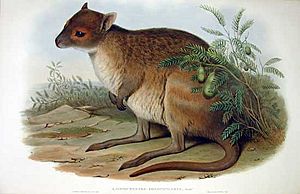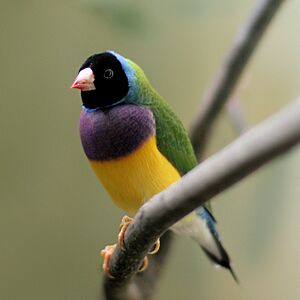Mornington Sanctuary facts for kids
Mornington Sanctuary is a huge nature reserve in the Kimberley region of north-west Western Australia. It covers about 3,582 square kilometers (1,383 square miles). This special place used to be a cattle farm called Mornington Station. Now, it's owned and looked after by the Australian Wildlife Conservancy (AWC). Their main goal is to protect the amazing plants and animals that live there.
Contents
What is Mornington Sanctuary?
Mornington Sanctuary is a large area dedicated to protecting nature. It's located in a wild part of Western Australia. The AWC manages it to keep the environment healthy. You can also find the Mornington Wilderness Camp here. It's a great place to learn about Australian wildlife.
A Look Back: History of Mornington
For most of the 1900s, Mornington was a large farm called a pastoral lease. It was mainly used to raise beef cattle. The name "Mornington" comes from the Mornington Peninsula in Victoria. In 2001, the Australian Wildlife Conservancy (AWC) bought the land. They wanted to turn it into a nature reserve. Their aim was to protect the many different kinds of life, known as biodiversity, in the area.
Land and Weather at Mornington
Much of Mornington Sanctuary is very rugged and wild. It includes parts of the Wunaamin-Miliwundi Ranges. The upper part of the Fitzroy River also flows through it. You can see flat-topped hills called mesas, like those in the Baulk Face Range. The Fitzroy River has deep, narrow valleys called gorges, such as Dimond Gorge.
Lake Gladstone, the biggest wetland in the Kimberley, is in the north-west. The land is mostly covered in tropical savanna. This means it has woodlands and grasslands. Wildfires often happen here, which helps shape the landscape. You can also find small patches of rainforest in places safe from fires. These areas might have special Livistona palm trees.
The weather here is tropical with a monsoon season. This means there are clear wet and dry times of the year. The wet season is from November to April. The dry season is from May to October. On average, about 700 millimeters (27.5 inches) of rain falls each year.
Amazing Animals of Mornington
Mornington Sanctuary is a very important place for birds. BirdLife International has called it an Important Bird Area (IBA). This is because it's home to many special birds. These include threatened birds like red goshawks and Gouldian finches.
Many other important bird populations live here too:
- grey falcons
- Australian bustards
- chestnut-backed buttonquails
- bush stone-curlews
- white-quilled rock-pigeons
- varied lorikeets
- northern rosellas
- purple-crowned fairywrens
- silver-crowned friarbirds
- Different kinds of honeyeaters (white-gaped, yellow-tinted, bar-breasted, and banded)
- sandstone shrike-thrushes
- white-browed robins
- spinifexbirds
- painted firetails
- masked and long-tailed finches
Besides birds, other special animals have been seen at Mornington. These include freshwater crocodiles and northern quolls. It's also likely that spectacled hare-wallabies, ghost bats, and orange leaf-nosed bats live here.
Getting to Mornington Sanctuary
Mornington Sanctuary is in a remote area. If you want to visit the Wilderness Camp, you need a 4WD vehicle. You get there by driving on the Gibb River Road. Then, you take a 90-kilometer (56-mile) road called Mornington Road. This road might be closed during the wet season.
Here are some driving distances and times:
- From Broome: 550 kilometers (about 7 hours)
- From Derby: 330 kilometers (about 5 hours)
- From Fitzroy Crossing: 385 kilometers (about 6 hours)
- From Kununurra: 565 kilometers (about 8 hours)
The Wilderness Camp also has an airstrip that is 1,000 meters (3,280 feet) long. You can arrange special charter flights to get there.



